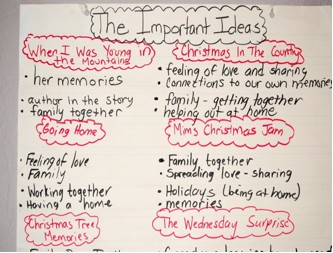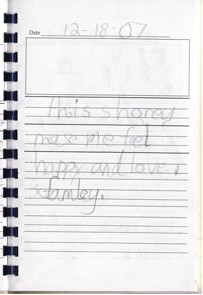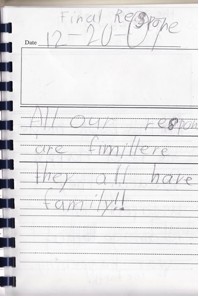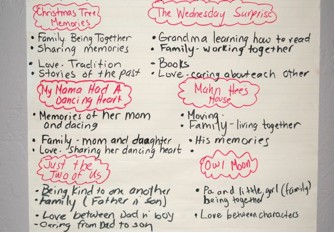Making Connections through Text Sets with Young Children
by Jennifer Griffith, First Grade Teacher, Van Horne Elementary School
Making connections is essential to learning, especially for young children. Kathy Short (1993) defines learning as “the search for patterns that connect,” and argues that learning is hindered by the fragmentation of the school day as children jump between classrooms and subjects. She believes that learners need to “constantly make connections across past and present experiences in order to construct their understandings of themselves and their world” (p. 284). As a teacher it is my job to offer many opportunities for children to make these connections in the classroom, even though finding the right books and activities at the right moment can be a real struggle with first graders. It is often a challenge to find materials that support young children in learning something new by connecting to something they already know.
I observed my students successfully using text sets in the Learning Lab to enhance their conceptual thinking about journeys by making connections between the books and their own lives. Text sets are a collection of conceptually related books that are used by a group of students for discussion and comparison (Short, 1993). These sets contain books that provide a range of perspectives on a theme or topic. Short argues that text sets elicit a different type of dialogue in literature discussions than occurs with a stand-alone book. Discussions of text sets involve more retellings and searches for connections and comparisons across books rather than focusing on students’ negotiations of their differing interpretations of a particular book. These discussions encourage students to engage in the cognitive strategy of intertextuality, the process of making meaning through connections across present and past texts and life experiences.
I was up for the challenge of bringing this type of thinking and talk into the classroom through our study of family memories. I wanted the kids to be introduced to a group of books that were connected by the significance of memory in our lives within families and in forming our identities. My goal was to enhance their thinking about literature and to encourage them to make connections to their own lives as well as between the books. I wanted the books in the text set to offer a range of perspectives so that the texts would play off of each other in the students’ discussions. These experiences would support them in our culminating activity of memory mapping where students would try out the same strategies we had been using in our conceptual idea of journeys–identifying, labeling journeys, and choosing a pathway to represent their memory.
I collected a set of books around the theme of families and memories. I strove to find as many as I could that were related to the holidays, since we were close to the winter break and students’ minds were on the upcoming holidays. The book titles I chose for this text set included:
A text set can be read with children in many different ways. Older students can each choose to read a different book from a text set and then share and compare their books in small group discussions. This strategy isn’t the most effective with young children, mainly because they are often unable to independently read the books. Ways of using text sets with younger kids include browsing the books in a set at the beginning of a new unit or focus, pairing two books in which there is some type of opposition, sending a text set home in a book bag for families to read together, or reading aloud a different book from the set each day. Another possibility is to read and discuss the same book in a small group with each group reading a book from the class text set. The kids can then reorganize after discussion to form text set groups so that each new group has one child from the previous groups (Short & Harste, 1996).
I decided to gradually build our text set by choosing one read aloud a day from our set to discuss as a whole class so that all of the kids could participate and understand the story. The significant part of this variation is maintaining a web or chart to show the different connections and comparisons across the books. Gradually creating the chart would support kids in searching for patterns that connect and thus engage them in intertextuality as a way of thinking about text and about learning.
I showed the kids a basket that contained our text set and explained to them that over the next several weeks we would read these as a class and discuss what we noticed. I let them know that I wanted them to think about why I grouped these books together and that they would be the ones titling our basket with the theme. The basket contained more books than the ones I read during our read-aloud time so that students would have more than just the ten books to browse during open reading time. Open reading usually occurred in the morning for about fifteen minutes, when the kids could read from all the books in the classroom, not just their “just right” books. My goal was to encourage them to make connections with as many books as possible, believing that this would support them in getting more out of the text set and being able to see more connections between the books and in their own lives. The kids were excited and I was eager to see their important ideas and connections.
We began with a read aloud of When I Was Young in the Mountains (Rylant, 1982). After I completed reading the book I asked the kids to arrange themselves in a circle to begin our discussion of the book. The kids knew that during a discussion they don’t have to raise their hands but do have to be respectful so as not to talk over one another and to be thoughtful in their listening and their speaking. Our discussions are open-ended, but if the kids get too away from the book, I guide them back gently to refocus their thinking. I don’t run the discussion but function as an observer and facilitator if needed. As soon as I finished the book, they began discussing the important ideas they noticed.
The kids had just finished an author study of Patricia Polacco and one of the important ideas they discussed was how she put herself in the story. I thought it was significant that they were continuing to notice this positioning by the author in this story.
I created many visuals to support the kids in seeing how the books fit together. They needed more than talk to explore the connections across books. We had the basket that housed our text set and each book was placed in the book display stand after being read aloud. We also had a chart titled “Our Important Ideas” where we wrote the titles of books as they were read aloud and listed what the kids saw as the important ideas. We wrote on the chart after our discussion in our circle, focusing on the “big ideas” that stuck out for them based on their conversations about a particular book. This routine continued throughout the text set and helped the kids see connections among the books because they had a visual to refer to during and after their discussion of each book.
We used our response logs as a place for the kids to reflect on their thinking about a particular book. We weren’t able to respond in our logs after each book in the set due to time limitations. The kids and I had worked on ways to respond and they knew to use phrases, such as “I wonder…”, “I think…”, “it reminds me…” or connections to the book. Their response logs included both writing and pictures. I encouraged the kids to write as much as they could about how the story made them feel and what they thought about the book. They could use the ideas discussed in our literature circle or something they didn’t get a chance to share. Their responses to When I Was Young in the Mountains included:
As we continued through our text set of families and memories the kids made connections and observations about what they noticed during discussion and in their response logs. The kids commented on the theme of love and sharing in Christmas in the Country, Going Home, and Mim’s Christmas Jam. The common thread the kids saw across most of the books still focused on the connection they had identified in When I was Young in the Mountains–the idea of memories and families working and being together. After reading The Wednesday Surprise and Christmas Tree Memories, about half way through our text set, the excitement level arose in our classroom. The kids couldn’t wait for their turn and began shouting:
It was rewarding to see the kids making these connections. Their thinking was encouraged by setting up the classroom to visually display the books as a set and charting their “important ideas.” It was obvious that the text set encouraged them to not look at literature in isolation but instead always in connection with other literature and their lives.
We completed our text set and our important ideas chart with the book Owl Moon. The kids talked about Pa and the little girl being together as a family and the love between the characters in the book.
I had the kids do a final reflection in their response logs to pull together their thinking and connections from the text set. Jacob wrote, “All the stories made me feel happy,” while Ayden commented, “All our responses are families, they all have family in them.” Matthew also picked up on this theme, writing, “All the stories made me feel happy and they all had love and family in them.”
I was pleased and reassured that text sets could be effective in a primary classroom. My first graders proved this with their understanding and ability to connect their past experiences with literature to the books in our set. They were also able to successfully make connections between the books in our text set by seeing and adding to our “important ideas” chart. The learning that took place during our text set confirmed research findings that indicate learning is enhanced when connections can be made to children’s existing knowledge and experiences. Implementing a text set into the curriculum with my first graders helped me more fully appreciate the importance of offering students the chance to connect to their prior knowledge to learn something new. We do a disservice to children and make learning more difficult when we expect students to learn something new without considering their life experiences and knowledge. Text sets establish a framework for kids to expect connections to their own lives and to other literature and to develop strategies for making those connections. We created a community of learners in our classroom who actively and critically search to make sense of their world and learning.
References
WOW Stories, Volume I, Issue 2 by Worlds of Words is licensed under a Creative Commons Attribution-NonCommercial-ShareAlike 4.0 International License.
Based on a work at https://wowlit.org/on-line-publications/stories/storiesi2/.





One thought on “WOW Stories: Connections from the Classroom”